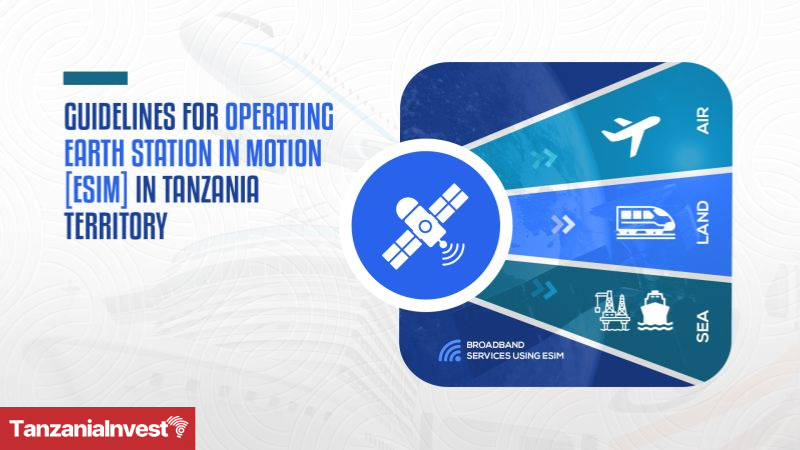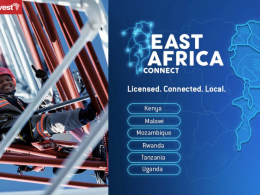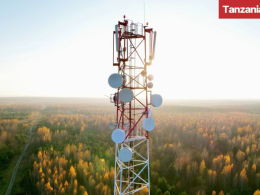The Tanzania Communications Regulatory Authority (TCRA) has issued guidelines for the operation of Earth Stations in Motion (ESIM) within Tanzania’s territory, airspace, and territorial waters.
The guidelines, effective July 2025, apply to ESIMs installed on land vehicles, aircraft, and maritime vessels, providing broadband connectivity while in motion.
They establish technical and regulatory requirements, licensing procedures, and frequency allocations for both domestic and visiting ESIMs.
The guidelines align Tanzania with international frameworks set by the International Telecommunication Union (ITU) through resolutions adopted at recent World Radiocommunication Conferences.
ESIM operators must obtain authorization from TCRA before starting operations in Tanzania, for both Tanzanian-registered platforms (domestic ESIMs) and foreign-registered vehicles, ships, or aircraft intending to operate within Tanzania (visiting ESIMs).
Domestic ESIMs are subject to license fees under the Electronic and Postal Communications (Licensing) (Amendment) Regulations, 2025, while visiting ESIMs are exempt from fees but must avoid harmful interference with local networks.
Frequency Bands
The document provides a detailed allocation of frequency bands for ESIM communications:
- For Geostationary Satellite Orbit (GSO) systems in the Fixed Satellite Service (FSS):
- 12.75–13.25 GHz (Earth-to-space, limited to aeronautical and maritime ESIM).
- 17.7–20.2 GHz (space-to-Earth).
- 27.5–30 GHz (Earth-to-space).
- For Non-Geostationary Satellite Orbit (NGSO) systems in FSS:
- 17.7–18.6 GHz, 18.8–19.3 GHz, and 19.7–20.2 GHz (space-to-Earth).
- 27.5–29.1 GHz and 29.5–30 GHz (Earth-to-space).
- For maritime and aeronautical ESIMs (Earth Stations on Vessels and Aircraft Earth Stations):
- 5.925–6.425 MHz (Earth-to-space).
- 14–14.5 GHz (Earth-to-space).
Certification Requirements
The guidelines specify that ESIM applications must include registration documents from relevant Tanzanian authorities:
- Aircraft ESIMs: certified registration from the Tanzania Civil Aviation Authority (TCAA).
- Maritime ESIMs: registration from either the Tanzania Shipping Agencies Corporation (TASAC) or the Zanzibar Maritime Authority (ZMA).
- Land ESIMs: vehicle registration from the Tanzania Revenue Authority (TRA).
Foreign-registered platforms must submit valid authorization documents from their country of origin.
Use and Impact in Tanzania
According to TCRA, the deployment of ESIMs will expand broadband access across the transport sector, covering aviation, maritime, and land mobility.
The availability of reliable satellite connectivity is expected to improve passenger services, enhance logistics efficiency, and support the country’s integration into regional and global communication networks.
The regulator further underlines that ESIMs are authorized only for broadband services and not for safety-of-life applications.
About Earth Stations in Motion (ESIMs)
Earth Stations in Motion are satellite terminals installed on moving platforms such as aircraft, ships, and vehicles, providing broadband connectivity for passenger services, logistics, and maritime operations.
In Tanzania, the introduction of ESIM regulations comes as the country continues to expand broadband access under its National ICT Policy, which promotes the use of modern communication technologies to support economic growth and digital inclusion.
Tanzania has already invested in terrestrial broadband infrastructure, including the National ICT Broadband Backbone (NICTBB), and is now complementing this with satellite-based connectivity solutions.
Regulated ESIM operations are expected to enhance internet access for air passengers, maritime operators, and ground transport services. This could support the tourism sector, improve logistics efficiency for regional trade, and strengthen Tanzania’s position as a hub for regional connectivity in East Africa.










